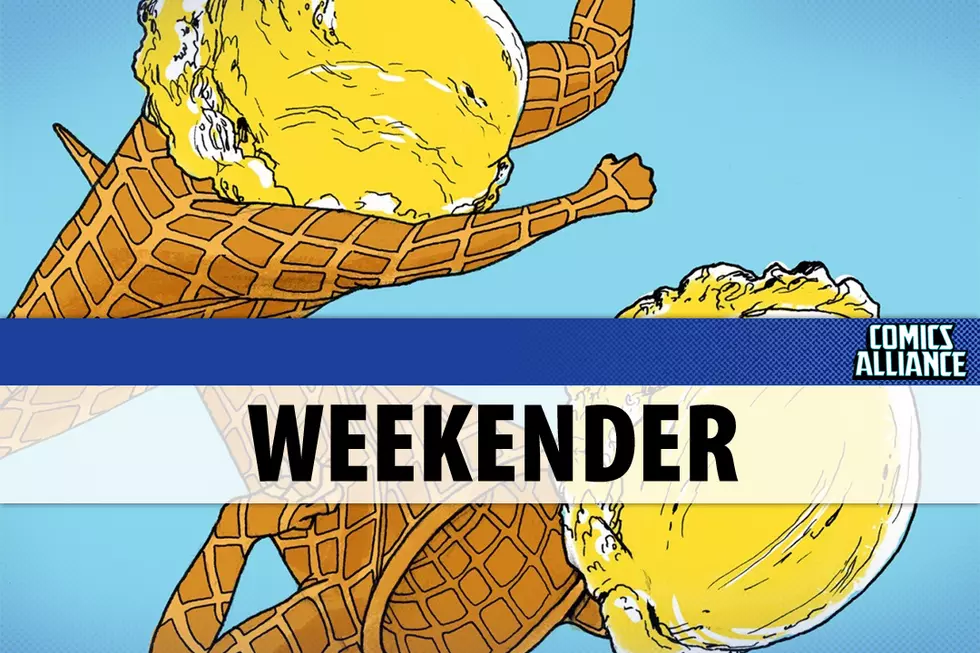![Breaking Platters Are As Entertaining As Spinning Platters: Ron Wimberly Talks ‘Martyr Loser King’ and ‘Gratuitous Ninja’ [Interview]](http://townsquare.media/site/622/files/2015/09/gratnin-feat.jpg?w=980&q=75)
Breaking Platters Are As Entertaining As Spinning Platters: Ron Wimberly Talks ‘Martyr Loser King’ and ‘Gratuitous Ninja’ [Interview]
Ron Wimberly has been working in mainstream comics for more than ten years, on projects like Metal Hurlant, Lucifer, and the Hellblazer Special: Papa Midnite; but it wasn't until his 2012 graphic novel Prince of Cats that he really exploded. Since then, he's worked on the interiors of books including She-Hulk and Prophet, and produced some exceptional cover work and character redesigns. More recently he announced two new creator-owned books with Image.
ComicsAlliance spoke to Wimberly to hear more about his plans for the near future, including his collaboration with Saul Williams, and the imminent return of Gratuitous Ninja.
ComicsAlliance: You're currently collaborating with musician/poet Saul Williams on a project called Martyr Loser King, which will include both a musical play and a graphic novel. Just those details alone, with the play on Martin Luther King's name, and a pair of media that aren't typically combined — it sounds incredibly interesting. What can readers look forward to seeing in the graphic novel?
Ron Wimberly: We’re still working out some the details, but I spent a bit of time building with Saul about the world and the characters. Saul’s created a whole world in music similar to what he suggested with the imagery from his [album] Niggy Tardust. We’re working out how to best bring what he started in the music/writing to life in comics form. Saul is a brilliant storyteller and this may be a start of a brilliant comics writing career.
I’ve already done some artwork for the project and Saul’s been leaking tracks and artwork on the Martyr Loser King Tumblr.
CA: What was the inspiration for the project and what was the process been like with you and Saul, who is --- among other things --- a poet, musician, writer, actor, and activist?
RW: I can’t tell what inspired him, or rather, I won’t, but he goes into it in an interview with Fader and more recently with Fact Mag. He tells it better than I ever could.
As for me, when Saul first mentioned Burundi to me --- first thing that came to mind were Burundi drums. I first heard them on Bow Wow Wow’s Radio G String, and a friend of mine hipped me to the history of the Burundi drums. When I told Saul what it meant to me and mentioned Musique de Burundi, he told me he coincidentally had that record hanging above his drawing table! Kismet!
Working with Saul is great and intimidating. He is a hero of mine; more so now than when we started. I have learned a lot about being an artist by watching him. I actually had no intention on working with another writer and was really thinking about quitting comics altogether when he reached out to me.
The project is just now starting to get under way visually. Had some false starts, but it’s coming along. Last year Saul, Anisia Uzeyman and Weyni Mengesha --- the theater component --- and me went to Banff Art Center to workshop the narrative. It was truly enlightening. I’ve been kind of steeping in the world since and am getting ready to pour that onto paper. We've mostly been playing so far though.
CA: What I love about the idea is the Afropunk-ness of it all --- that is, black involvement and intersection with the largely white-dominated punk and alternative cultures --- which is sort of represented in Saul Williams’ work. But then it breaks into other alternative cultures too, not just in the musical sense, but also in other ways — perhaps an Afro-cyber-punk aesthetic and theme. The protagonist is a hacker in Burundi, and hacker cultures are often subsumed into alternative ones and frequently align with alternative music. Do any of those intersections speak to you? Do you think they’ll speak to readers?
RW: Saul’s music kind of defies definition right now. Closest comparison I can think of is the stuff they were doing in NY back in late 70s, early eighties called No Wave.
The story — I don’t know enough about cyberpunk to classify it as cyberpunk or not.
By my understanding of Afropunk, I wouldn’t call this Afropunk. But just to put it out there, by your definition, Punk is Afropunk. Feel me? Punk is built on black culture. I loved the Afropunk film when it first came out. I dig how important “Afropunk” as a label was to acknowledge people who felt marginalized within punk. We need a paradigm shift past that sort of thinking because now Afropunk functions mainly as marketing/branding. I think it’s okay to own punk altogether. Make a prefix for every other type of punk that’s not inclusive.
My thinking on punk — this is gonna become an interview about what Ronald Wimberly thinks punk is, ha! — my “punk”, conceptually, is a type of cultural iconoclasm. I think it’s just a sort of creative nihilism... with a new name. If American culture has historically been polarizing, white supremacist and sexist then punk should destroy those norms.
Historically, the sonic component to that is a return to form for rock and roll, no solos, no big production. No virtuosity required. Sound as vehicle for radical ideas. If I’m forced to define punk, I would say it is the intersection of these things confined to a moment in history. I feel like once you can put a name on it, it’s dead.
What exists now is a sort of aestheticised version of punk. I don’t feel our work can be placed in the contemporary aestheticized version of the punk tradition. It’s something new, so maybe it requires a new name…but after it’s dead with pins in its wings.
CA: Martyr Loser King is going to be published with First Second Books. How have you enjoyed working with them?
RW: I love it! They’ve been very patient so far. Mark Siegel has been very accommodating and is pulling together a lot of the disparate elements for this project. But that's on the front end; ask me again a quarter after the book ships.
CA: You're working on so much right now. Between Martyr Loser King and your two new Image books, Slave Punk and Sunset Park, your days have to be packed. How have you been keeping all these plates spinning?
RW: … Boy, are my arms tired. (rimshot)
I keep’m spinning because I can’t afford new plates! I had rough times so I stopped saying no to work. I am now in a place where I have to actually turn down work. It’s work but I love it though. I’d also been on the road from April till August. I’m really looking forward to getting back to New York, to my studio.
Either way, breaking platters are as entertaining as spinning platters.
CA: You've been working on a project, Gratuitous Ninja, or GratNin, off and on for several years now. How would you describe it to a new reader?
RW: It’s in the name. Gratuitous Ninja. It’s always been a variation on that theme. This time out, a centuries old shinobi clan rehabs three young, neighborhood delinquents --- a weed dealer, a fast food deliveryman and a vandal.
The new young shinobi are eager to cut, stab and jutsu their neighborhood into a better place. The only thing is that their elders, a family of pacifist, food co-op running shinobi, strictly forbade the chunin from using their ninja skills in the streets. So when the young ninja decide to go behind their elder’s backs to fight pyrate thugs, things get... complicated.
CA: In 2002, you did a GratNin comic that pushed back against GMO foods — well before controversy began to build in the US in 2009-10. What about that topic called to you?
RW: You know, I really can’t tell you. It’s been so long. I like food. I have an imagination. I drew a comic about the future. The central character is a little girl. At the time I was imagining what the world would be like for... if I had a daughter with the woman I was seeing at the time.
CA: Just from the title alone, it's obvious that GratNin has some of its roots in Japanese culture. From one black nerd into Japan's history and culture to another — in 6th grade, a friend lent me some Sailor Moon manga and I never looked back — how did that interest start? Have any of those early influences made their way into GratNin?
RW: Hahaha, I don’t identify as a nerd. My interest in any particular culture or history doesn’t inform my identity to that degree. I just have interests. I travel. I read. I research my work. I wrote an essay about it.
I grew up watching Japanese animation, playing Japanese games, etc. etc. Just like nearly everybody else, so it’s on my palette. It's not exceptional.
GratNin is squarely rooted in American culture. American culture has Japanese culture in it; this is what GratNin is, down to it’s lens (my lens) on Japanese culture. At its root, GratNin is about American issues of community, urban planning, the prison industrial complex, cultural appropriation, cultural commodification and identity framed in the language of shoujo, shounen, seinen, and gekiga.
Some Japanese influences that have made it into GratNin are Yuri Kochiyama; I was inspired by historical figures like Ito Noe, Hiratsuka Raichou and the Seito group; formalistically, I am studying/contrasting the ninja genre works of Shirato Sampei and Kishimoto Masashi.
I keep a Tumblr that aggregates a bunch of stuff that inspires GratNin or resonates with GratNin. It’s literally a media mixtape of GratNin.
CA: The publication pattern --- whether online or in print --- has been pretty sporadic up to now, but, can we expect more GratNin soon?
RW: Sure. GratNin will drop weekly in the fourth quarter of 2015, but that’s all I can say for now. It's going to be part of something really exciting that I can't say much about right now. Stay tuned to gratnin.tumblr.com to know for sure.
More From ComicsAlliance

![Everything We Can’t Wait To See At San Diego Comic Con, Part Two: Saturday & Sunday [SDCC 2016]](http://townsquare.media/site/622/files/2016/07/SDCC-Sat1.jpg?w=980&q=75)



![Study Group Goes All-Out With 3D Comics Bonanza [Preview]](http://townsquare.media/site/622/files/2014/09/Untitled-157.jpg?w=980&q=75)



